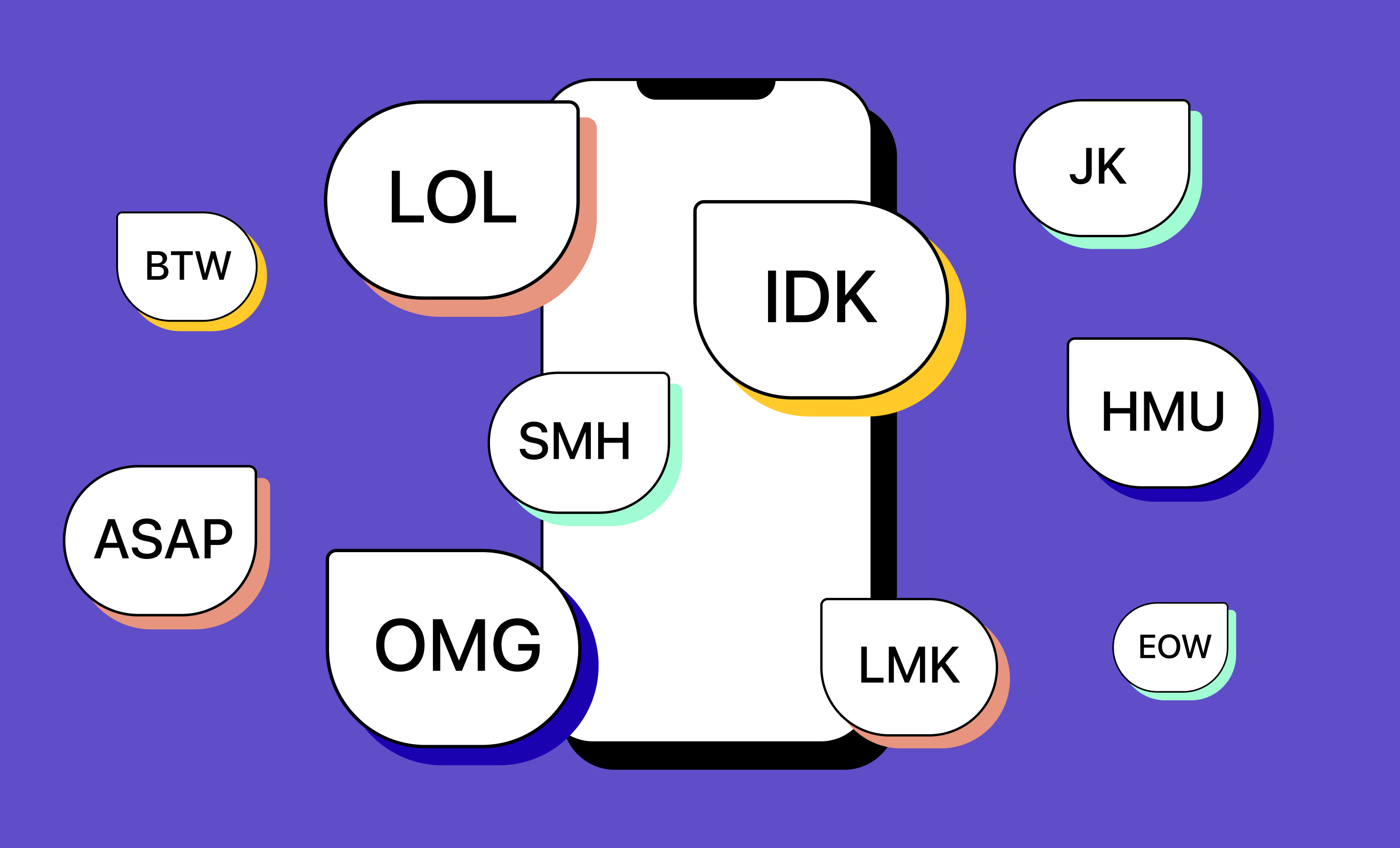Texting has made it easier to communicate—in most cases. But sometimes you run into phrases or words you don’t understand. That’s when you find yourself asking questions like what does LOL mean in texting, what does OMG mean in texting, or what does HMU mean in texts?
Words like LOL, OMG, and HMU are text abbreviations. They’re simply shortened versions of longer phrases. They help people write more quickly. In many cases, using them has become a habit for heavy texters. (They’re even finding their way into our everyday language.)
Read on to learn what abbreviations are compared to acronyms, when people use text abbreviations, when you should use them, and what the most popular text abbreviations are.
In this article:
- Comparing abbreviations to acronyms
- When do people use text abbreviations?
- Top text abbreviations
- Personal text abbreviations
- Business text abbreviations
- When should you use text abbreviations?
- TL;DR
Comparing abbreviations to acronyms
As we mentioned, abbreviations are shortened versions of longer phrases. They help people communicate more quickly.
There are multiple kinds of abbreviations:
- Initialism: formed from the first letters of a group of words, and pronounced letter by letter. AKA is an example of an initialism. LOL is also sometimes pronounced as an initialism.
- Acronym: formed from the first letters of a group of words, and pronounced as a word. ZIP (zone improvement plan) is an example of an acronym. LOL is most frequently pronounced as an acronym (“lawl”).
- Shortening: refers to a word where the beginning or ending of the word has been cut off. App (application) is an example of a shortening.
- Contraction: words where letters are omitted from the middle. Don’t, rly, and govt are examples of contractions.
You’ll probably run into all of these types of abbreviations in texts. However, the most common (and the most exclusive to texting) are acronyms.
When do people use text abbreviations?
People might use text abbreviations by habit. They may use them when they’re in a hurry. Alternatively, they may use them in conversations when they start to feel at ease with you. No matter the cause, people using abbreviations with you is a good thing.
Text abbreviations show you that the people you’re texting feel comfortable using casual language with you. SMS is a convenient channel for them, and by using their favorite text abbreviations, they’re making the channel even more useful.
Understanding what people—whether they’re friends, colleagues, or customers—are saying when they use text abbreviations is important. If you understand them and can respond appropriately, they will feel comfortable communicating with you in the future.
Top text abbreviations
So now to the main question: what does LOL mean in texting? And which text abbreviations can you expect to see from your friends, colleagues, and even customers?
Here are some of the most popular text abbreviations you’ll come across in everyday messaging and how to use them.
What does LOL mean in texting
According to this sparse University of Calgary – Department of Computer Science webpage, the LOL acronym originated on a local Bulletin Board System (BBS) called ViewLine some time in the 1980s. Its origins are exactly as you expected: it was when someone would literally laugh out loud in person and over time used the shorthand acronym LOL to represent his real-time expressive joy.
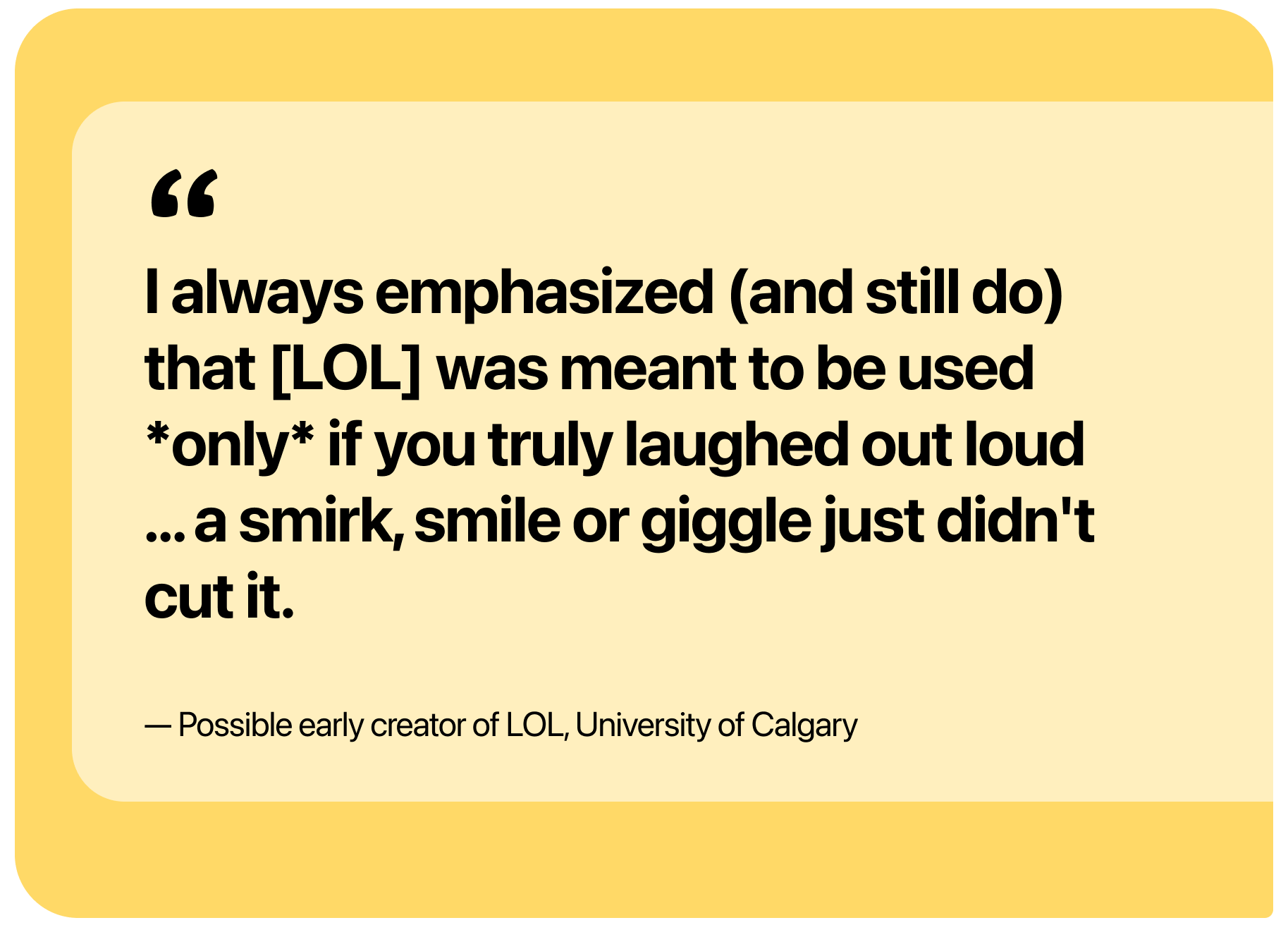
LOL can be used in response to something funny:
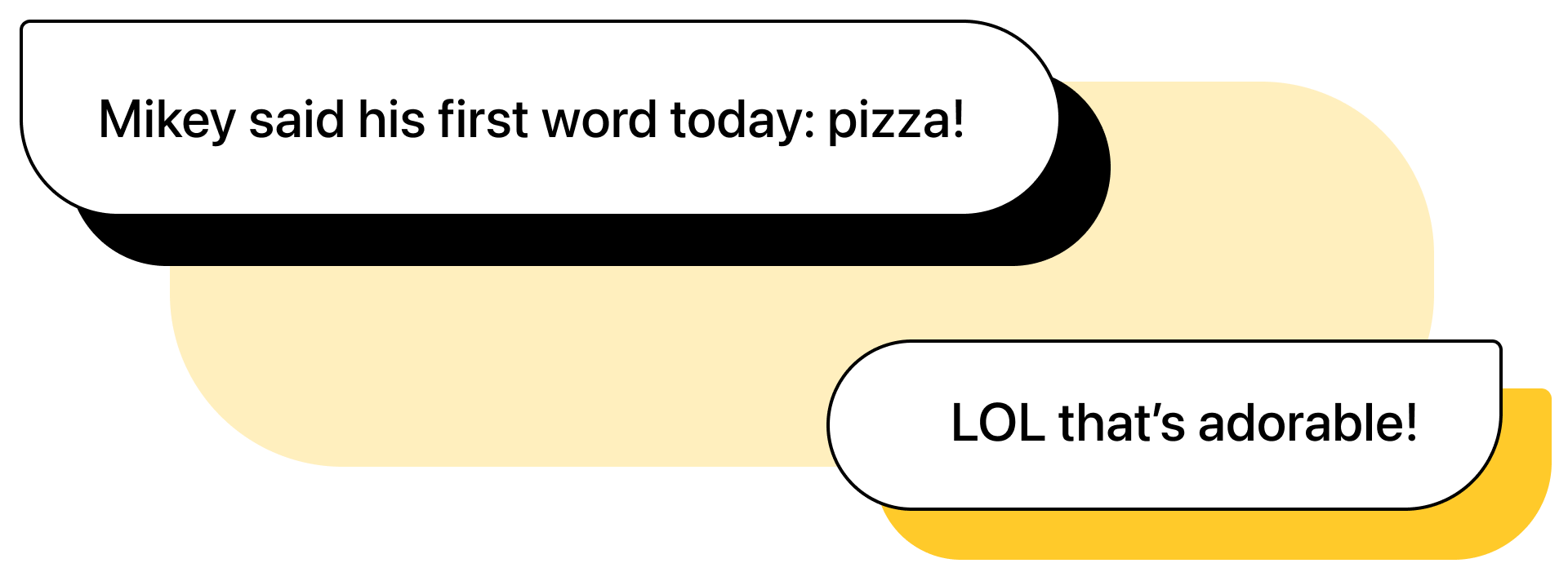
LOL can also be used sarcastically or to show that something’s not serious:

What does HMU mean in texting?
HMU, or “hit me up,” can be a confusing texting abbreviation to come across because even if you know what it stands for, its meaning isn’t entirely straightforward.
“Hit me up” means to get in contact with someone. It originated as a result of pager usage in the 90s, where the device would light up and beep to get the user’s attention. It continued to be popular in chat rooms during the rise of the internet and continues to be used in texting today.
HMU can be used to make plans:

It can also be used when someone contacts you:

What does BTW mean in texting?
BTW is an acronym for “by the way” that can be traced back to 1989. It’s commonly used in personal messaging like texts or social media to mean “also” or “additionally.” It has been used to abbreviate “between” in the past, but most of the time, it means “by the way.”
BTW can be used to add another topic to your message without sending a second message:

You could also use BTW to change topics:
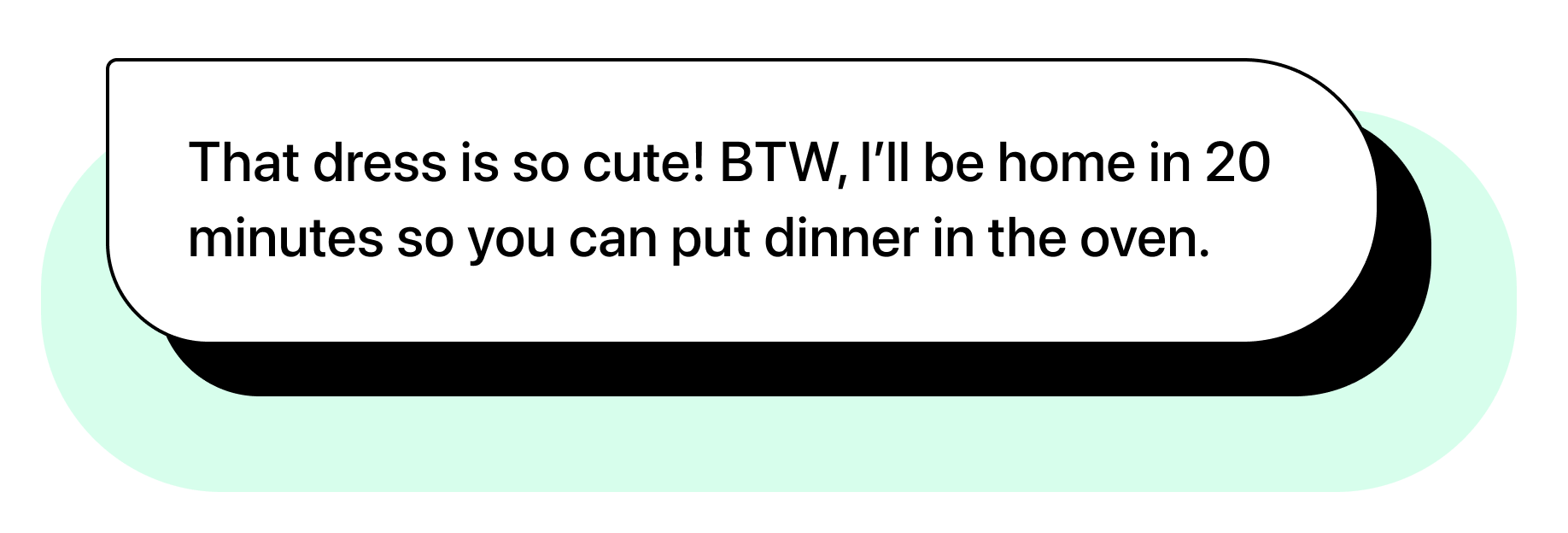
What does LMK mean in texting?
LMK means “let me know.” It rose to prominence through chat rooms in the 90s and is generally used to elicit a response from someone. You won’t usually use LMK for business purposes, but it’s used in all forms of texting for impersonal conversations and to encourage communication.
LMK can be used as a reminder for the recipient to respond:
![Illustration with chat bubbles. First chat bubble: "Hey, what time are you going to be ready tonight? [12:15 PM]". Second chat bubble: "LMK ASAP - I still need to make a reservation. [4:05 PM]"](https://www.heymarket.com/wp-content/uploads/2023/07/Lol-chat-7.png)
It can also be used to ask for feedback:
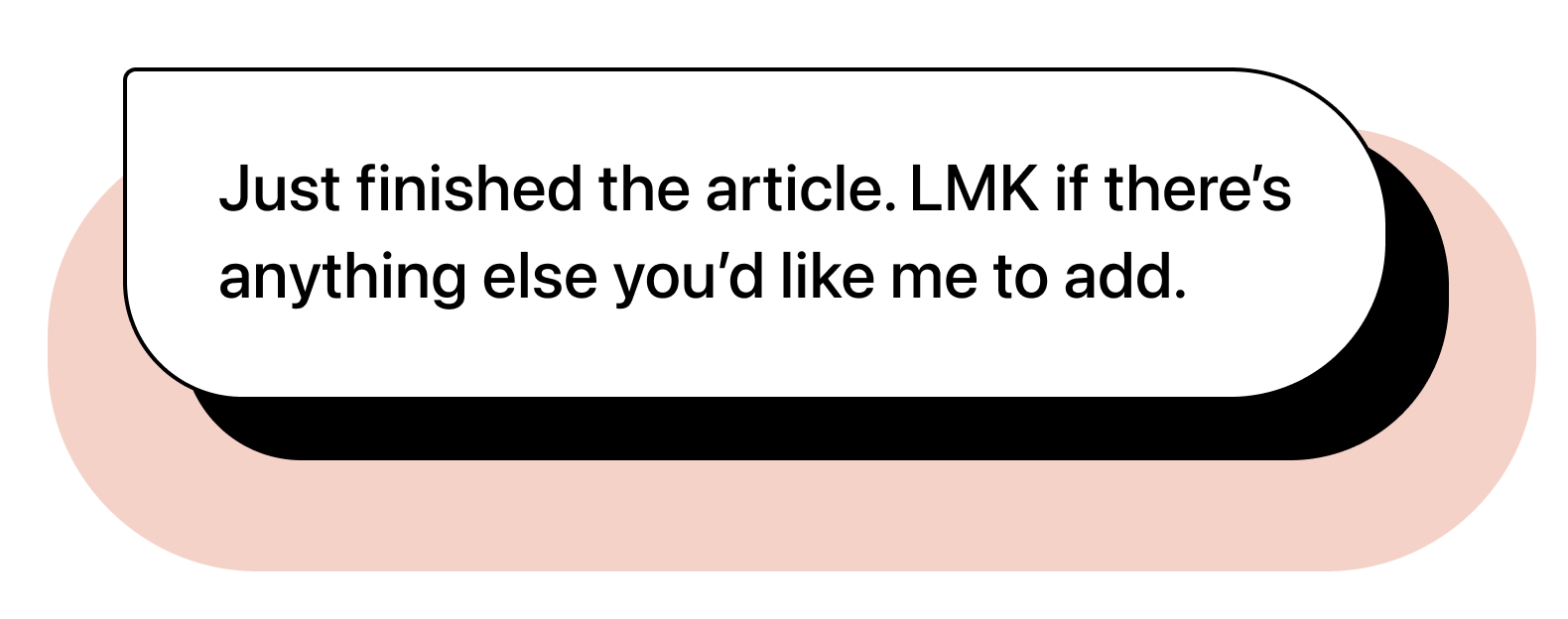
What does IDK mean in texting?
IDK is an incredibly common acronym for “I don’t know.” It’s used in the same way that you use the full phrase: to say that you aren’t sure about something. It’s commonly used in the lowercase form of “idk” to avoid coming across aggressively, or like you’re shouting.
IDK can be used to signify that you’re unsure about something:

“Idk” can also be used when you don’t have the answer to a question:
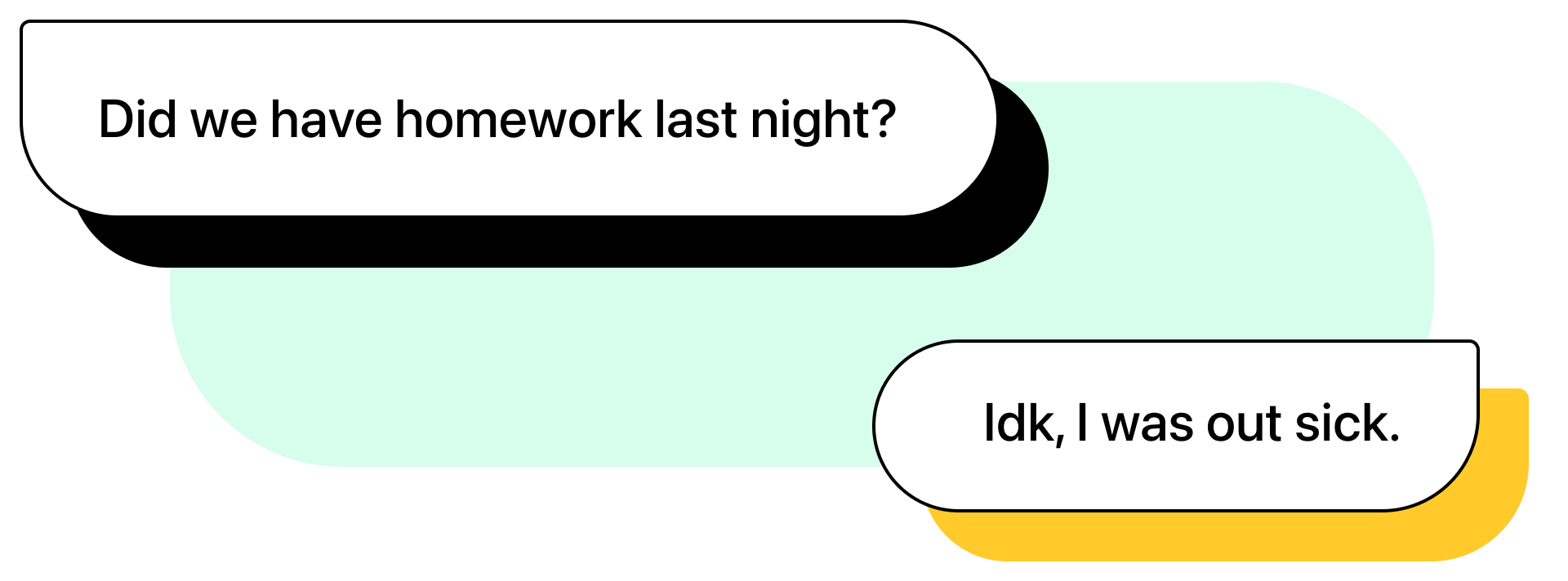
What does SMH mean in texting?
SMH, or “shaking my head,” can be an initialism or acronym. It’s generally used as an initialism because the phrase “shaking my head” is not often written out or spoken, so the abbreviation has taken on a meaning of its own.
SMH is generally used to convey disappointment, frustration, or impatience, so it’s reserved strictly for personal use.
SMH can show disappointment:
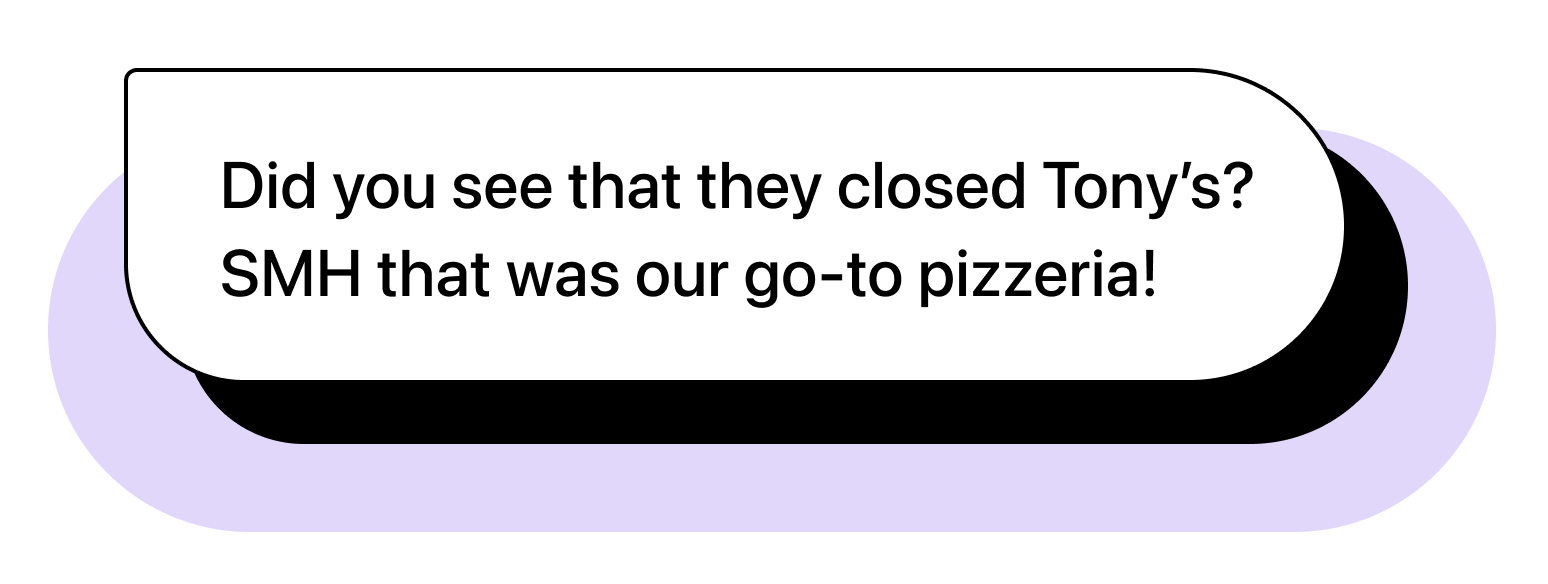
It can also express frustration:

What does WTM mean in text?
WTM can stand for several things depending on the context. It’s most often used to mean “what’s the matter?” asked when there seems to be a problem:

It can also be short for the slang phrase “what’s the move?” used when asking a friend what the plan is for the evening, specifically what the next event or venue they want to go to.

The third most-used version of WTM is used as shorthand for “whatever that means” commonly in a long message used to complain or inquire about what someone said. This usage became popular as an oft-used meme that featured a snippet of Nene Leakes of The Real Housewives of Atlanta saying “okay… whatever that means”

More common abbreviations for personal use
While we’ve highlighted some of the most used abbreviations you’ll come across, the full list is expansive and always growing.
Below, we’ve listed some more of the most common abbreviations you’ll find in texts, an example of a sentence in which they might be used, and a mini history lesson when possible:
| Text abbreviation | Definition | Example | Fun facts |
| AFAIK | as far as I know | “AFAIK, she left the party ten minutes ago.” | The earliest dated definition for AFAIK can be found on the website Urban Dictionary. It was written in 2003. |
| AFAIR | as far as I remember | “She started that fight AFAIR.” | |
| AKA | also known as | “Joe, AKA our principal.” | Jennifer Lopez’s eighth studio album is titled A.K.A. It is also the title of one of the songs in the album. |
| AMA | ask me anything | “I have taken the test before. AMA.” | Reddit is a large online platform that features user-led discussion boards. It has a subReddit (a dedicated discussion board) called “r/IAmA.” On this discussion board, users submit “AMA interviews.” They say who they are and what they do, then ask other users to ask them anything (AMA). |
| Appt | appointment | “Don’t forget that dentist appt we have at 4pm.” | This term is used for both doctors’ appointments and appointments to positions, like judicial or business roles. |
| ASAP | as soon as possible | “Can I have that shipped ASAP?” | ASAP was initially an uncommon initialism used in high-pressure environments, like on Wall Street, to request that a task be completed quickly. It became common (and pronounced as an acronym) with the rise of email and internal messaging systems. |

| AYOR | at your own risk | “Try that cookie dough AYOR.” | While this abbreviation attempts to deflect blame from one party, it is only used in casual conversations. You would never see a legal document with AYOR on it. |
| B4 | before | “I turned off the stove b4 I left.” | This acronym was so popular in 1999 that a boy band named themselves b4-4. Later, they rebranded to before four. |
| BAE | before anyone else | “BAE, you know I’ve got your back.” | This term refers to a favorite person; it can also be a shortened form of baby. |
| BC | because | “She left bc she was bored.” | When capitalized and used in academic or historical writing, this acronym means “Before Christ.” This refers to the years before the year 0 (e.g., 500 BC). However, many modern publications use BCE, which means “before common era.” |
| BRB | be right back | “I need to find the shipping number. BRB.” | BRB originated in the 1990s when chatrooms first became popular. It was an easy way to explain that a person would be stepping away from their keyboard for a few minutes. |
| DIY | do it yourself | Ex. “Is this supposed to be a DIY furniture setup, or is it a white-glove delivery?” | The term DIY became popular in the 1950s, when self-made projects became all the rage. |
| DM | direct message | “I sent him a DM on Instagram, but he hasn’t responded.” | The term DM grew popular on Facebook and Twitter, but is now used to refer to direct (private) messages on any social media platform. |
| DYK | did you know | “DYK Angie is going to be on vacation next week?” | |
| ESP | especially | “I thought that was an ESP good presentation.” | ESP is also the acronym for “extrasensory perception.” People with ESP believe they can sense information through the mind. (Think: people who can read minds and see the future.) |
| FB | “My grandma’s finally got herself a FB account.” | This abbreviation is used both in everyday language and throughout the social media advertising industry. | |
| FOMO | fear of missing out | “I don’t really want to go but I’ll get FOMO if I don’t.” | FOMO has become such a popular term—and prevalent problem—that health magazines center articles around it. |
| FR | for real | “Let’s go FR, I’m dying to see them perform.” | |
| FRFR | for real for real | “I think he likes you, FRFR.” | FRFR is a more serious version of FR. |
| FTW | for the win | “That’s the Packers FTW!!” | FTW can either indicate an actual win in a game or imply that something is excellent or the greatest. |
| FWIW | for what it’s worth | “FWIW, I prefer the red dress.” | This term is used to politely introduce an idea, especially one that might contradict the other person’s viewpoint. |

| FYI | for your information | “FYI, I just renewed my subscription before the account closed out on me.” | FYI is most often used in informal situations like SMS chats. It’s also used in formal emails or documents to attract the readers’ attention. |
| G2G | got to go | “Sorry I missed you, but I’ve G2G.” | G2G can also mean government to government. An official may use it when referring to sharing data or intelligence between government agencies or departments. |
| HBD | happy birthday | “HBD, Molly.” | HBD can be seen as a lazy or rude way to send birthday wishes. Consider sticking with the full phrase if you’re talking to someone you care about! |
| HBU | how about (’bout) you | “I’m tired, HBU?” | WBU, which means what about (‘bout) you, can be used instead of HBU in many situations. |
| IDC | I don’t care | “idc where we go for dinner.” | IDC is almost always written in lowercase letters to support the apathetic nature of the term. |
| IG | “I posted the pic on IG.” | Instagram is owned by Facebook (AKA FB). | |
| IM | instant messaging | “Remember when we used to IM on Yahoo? Those were the days.” | IM is now the term used for most real-time communications over the internet, including messaging through channels like Facebook Messenger and live chats on websites. |
| IMHO | in my humble opinion | “She’s wrong about that IMHO.” | While the H in IMHO has long been established as “humble,” popular internet polls found that more people think the H stands for “honest.” It’s another example of people using abbreviations long enough for the real meaning to be challenged. |
| IMO | in my opinion | “We should go Friday, IMO.” | |
| IMU | I miss you | “It’s been so long! IMU” | IMY is often used instead of IMU. |
| IMY | I miss you | “Thinking about u lately…IMY” | IMY is such a popular abbreviation that it was used as a title in a song: I.M.Y. (I Miss You) by Kodak Black. |
| ILY | I love you | “Thanks Tina, ILY.” | ILY is a less serious version of “I love you.” It’s most often a term of admiration or fondness, rather than full-blown love. |
| IRL | in real life | “Is there an associate I can chat with IRL?” | IRL is often used in online spaces like social media or video games to refer to our normal, non-digital lives. |
| JIC | just in case | “I packed an emergency winter bag JIC.” | |
| JK | just kidding | “You look ridiculous. JK.” | JK got its start in 1990s chatrooms, and continued to rise in popularity throughout the 2000s. As it is sometimes difficult to convey emotions in messages, it was commonly used to ensure the mood of chats were sufficiently light. |

| JSYK | just so you know | “JSYK, the venue is closing at 2.” | |
| LGTM | looks good to me | “LGTM. Go ahead and place the order.” | |
| LMAO | laughing my a** off | “LMAO! I can’t believe I was using the wrong button all along!” | LMAO is a stronger version of LOL. You can use it to show that you’re laughing hard, as opposed to just laughing. |

| MFW | my face when | “MFW I saw the trailer for the newest Marvel movie…girl, I cannot handle it.” | This abbreviation is often followed by a GIF or emoji depicting how the person felt. |
| MRW | my reaction when | “MRW I saw my test results 😭” | This abbreviation is interchangeable with MFW. |
| MSG | message | “Your last msg confused me.” | |
| N/A | not applicable | “N/A. I don’t have a cat.” | N/A is most often written down on a form when you can’t provide an answer to a question. |
| NBD | no big deal | “I don’t mind that you missed the show, it’s NBD.” | NBD can be used to indicate that something is not a problem or to sarcastically indicate that something is a big deal (in the case of humblebragging). |
| NGL | not gonna lie | “You scared me, NGL.” | NGL is a newer acronym. It was started sometime around 2010, when it was first added to Urban Dictionary. |
| NP | no problem | “NP, I understand it’s not your fault.” | NP can be used in lieu of YW. |
| NSFW | not safe for work | “Don’t open the article until you get home. It’s NSFW.” | You’re likely to see this acronym tagging certain posts on Reddit. |
| NVM | never mind | “NVM, it’s working now.” | NVM is sometimes written as “NVMD” or NM.” |
| OMG | oh my god | “OMG I didn’t even think of that.” | OMG is over 100 years old, having been used in a letter written to Winston Churchill in a letter in 1917. The initialism became commonly used in 1990s chat rooms as a way to express shock. |

| OMW | on my way | “I’m OMW” | OMW can mean you’re in the car en route to a meeting place. It can also be used more loosely to mean you’re in the process of getting ready. |
| OP | original poster | “The OP can’t reply because they aren’t tagged in this post” | OP is a term commonly used in Reddit to express that the person who submitted a post reposted it from another source. |
| OS | operating system | “My phone has a different OS; that’s why our phone screens look so different!” | Mobile operating systems include Apple iOS, Android, Bada, Blackberry OS, Windows OS, Symbian OS, and Tizen. |
| OTW | on the way | “Are you OTW?” | |
| RLY | really | “That seems rly late.” | O RLY? is an internet-specific phrase meant to express extreme disbelief. |
| RN | right now | “I can take a call rn if that works.” | People have used RN since the internet chatrooms of the 1990s. |
| ROFL | rolling on the floor laughing | “That’s too funny! ROFL.” | ROFL dates back to around 1989, when it was first used in a post on an early internet message board called Usenet. |
| RSVP | répondez s’il vous plaît | “Have you RSVP’d to Joan’s party yet?” | This translates to “please respond”; hosts commonly include the abbreviation RSVP in event invitations. |
| RT | Retweet | “RT to support my friend!” | Retweet is a Twitter term. It refers to sharing someone else’s original tweet (post). |
| SGTM | sounds good to me | “I love that idea! SGTM.” | SGTM is also sometimes abbreviated as SG2M. |
| SMS | short message service (texts) | “Can you send me the address through SMS?” | The concept of the SMS message is attributed to Friedhelm Hillebrand and Bernard Ghillebaert in 1984. The first real text was sent by Neil Papworth in 1992. |
| SRSLY | seriously | “She is SRSLY mad.” | Used alone, SRSLY can effectively convey disbelief in a texted conversation. E.g., “SRSLY?” |
| SO | significant other | “Can I bring my SO to the party?” | An SO can refer to a spouse, life partner, or any long-term relationship. |
| TBA | to be announced | “The event dates are TBA, but I think it’ll be sometime in November.” | TBA is interchangeable with TBD, which means “to be declared.” (TBD is also defined as “to be determined” in some cases.) |
| TBC | to be confirmed | “The awards dinner starts at 9pm. The menu is vegetarian casseroles, meat options TBC.” | |
| TBH | to be honest | “TBH, I think I want to return it at this point.” | TBH can be used to admit a secret or to emphasize that you’re giving your honest opinion; sometimes it indicates that a hard truth may be coming. |
| TGIF | thank God it’s Friday | “I’m exhausted. TGIF.” | There are multiple songs that use this acronym, including “Last Friday Night (T.G.I.F)” by Katy Perry and “T.G.I.F.” by Lonestar. |
| THX | thanks | “I got it in the mail, THX for sending!” | |
| THNKS | thanks | “thnks Jane, really appreciate that” | This often-sarcastic abbreviation was made famous by Fall Out Boy’s hit song, “Thnks fr th Mmrs.” |
| TIA | thanks in advance | “TIA for your help.” | Some language experts suggest that TIA can come across as passive-aggressive. Consider skipping straight to THX or TY! |
| TIHI | thanks, I hate it | “So about that spider video…TIHI” | This term is used for photos, videos, or pieces of information that make someone uncomfortable. It can be used in response to conventionally scary, creepy, or awkward content. |
| TIL | today I learned | “TIL Bob was in a kids’ bowling league. He obviously won the game.” | TIL is always used before introducing interesting new information. |
| TLDR | too long; didn’t read | “TLDR. Can you send a summary?” | While the exact origins of the phrase aren’t known, it is suspected that TL;DR got its start from discussion boards like the Something Awful Forums during the early 2000s. The phrase was used then (and is used now) to give a quick summary of a longer article. |

| TLTR | too long to read | “Send me a summary—it’s TLTR.” | |
| TMI | too much information | “I’m glad you’re feeling better, but also, TMI.” | TMI is a casual way to let friends know you’re uncomfortable with the personal information they’re sharing. |
| TMRW | tomorrow | “I have time tmrw to pick it up.” | There are two abbreviations of tomorrow. TMRW is more commonly used, but TMW is an acknowledged alternative. |
| TNTL | trying not to laugh | “Oh noooo that’s horrible…TNTL” | This acronym may have started with a 2008 YouTube challenge in which a player finds funny videos and watches them without laughing. (The challenge continues on Instagram and other social media channels today.) |
| TTFN | ta ta for now | “Got it, that’s all I needed. TTFN!” | TTFN is an initialism of a popular British phrase. A British radio program that ran from 1939-1949, It’s That Man Again, created it to satirize the military’s use of initialisms. |
| TTYL | talk to you later | “I’ll message in once I find the part. TTYL” | From the late 1990s to the early 2000s, TTYL was the most popular way to say goodbye to friends via SMS. |
| TW | “I’m tired of blogging…I’m just gonna post my thoughts on TW.” | ||
| TY | thank you | “TY for the support.” | |
| TYSM | thank you so much | “TYSM for your help!” | TYSM is an exaggerated version of TY. Depending on the context, it can be read as enthusiastic or sarcastic. |
| WBU | what about you? | “I’m gonna leave. WBU?” | This term is synonymous with HBU in many cases. |
| W/O | without | “Do you have anything w/o dairy?” | Some say that this acronym started in the 1950s with waitresses. They could write down customer preferences more quickly by replacing the words with and without with W/ and W/O. |
| YNK | you never know | “YNK who is watching.” | |
| YOLO | you only live once | “I should have stayed in and studied, but YOLO.” | This acronym was first recorded in 1996, and began to decline in popularity around 2012. It has been featured in songs (like Drake’s “The Motto”) and parodied in songs (like The Lonely Island’s “YOLO”). Additionally, Mickey Hart, drummer of the Grateful Dead, has a house named YOLO. |
| YW | you’re welcome | “YW! I hope this helps other people with this problem, too.” |
Business-specific abbreviations
The rise of tools like Slack, G-Chat, and business text messaging means that many professionals now use abbreviations to speed up their internal communication. Along with the more general terms above, you may see more business-specific terms like those below:
| Text abbreviation | Definition | Example | Fun facts |
| AP | accounts payable | “Gina is handling AP. The bill will be sorted by the end of the week.” | A high AP amount means your business owes vendors money. |
| AR | accounts receivable | “Hey, have you followed up with them on AR yet?” | A high AR amount means a lot of your cash flow is tied up in unpaid invoices. |
| ASAC | as soon as convenient | “Can you send that over ASAC?” | There is a movement to stop using urgent terms like ASAP in offices, as they create an unhealthy sense of urgency when used too often. ASAC is a good alternative. |
| B2B | business to business | “She’s a B2B freelancer, so I’m sure she can write a blog post about marketing software.” | B2B refers to goods or services sold between businesses, but sometimes B2B businesses also make sales to consumers. |
| B2C | business to consumer | “We’re a B2C startup that sells dog costumes to pet owners.” | |
| B2G | business to government | “As a B2G contractor, our employees get security clearance.” | Business to government (B2G) is also known as business to administration (B2A). It refers to the sale of goods or services to any government, whether it’s federal, state, or local. |
| BAU | business as usual | “It didn’t snow, so we’re still on, BAU.” | Originally used in the 1800s, this term referred to maintaining normal business activity despite natural disasters or other potential interruptions. In 1914, it became more commonly used to refer to keeping normal life going during war-related disturbances. |
| BR | bounce rate | “Can you check on the BR for that last set of emails?” | This term is used in internet marketing. It refers to the percentage of users who visit one page of a website without looking at other webpages. It also refers to the percentage of emails that went undelivered in an email marketing campaign. |
| CEO | chief executive officer | “The CEO always attends high-level meetings.” | CEO is a well known acronym in part because the CEO is often a public-facing role. Apple CEO Steve Jobs, for example, has been featured in several shows and movies. |
| CFO | chief financial officer | “I’ll get the budget approved by the CFO before I announce it.” | |
| CIO | chief information officer | “It’s definitely time for a computer upgrade—let’s bring it up to the CIO.” | |
| CMO | chief marketing officer | “Have you run the new website design by the CMO?” | In the healthcare industry, CMO might also refer to a chief medical officer. |
| COB | close of business | “I’ll have that report to you by COB.” | COB specifically refers to U.S. standard business hours. In other words, it means 5:00pm. |

| COO | chief operating officer | “I think our office manager reports to the COO—maybe ask her where the snack budget’s gone?” | |
| COP | close of play | “Can you have that to me by COP?” | You can use COP interchangeably with end of business (EOB), end of play (EOP), end of day (EOD), and close of business (COB). |
| CPA | certified public accountant | “The business is big enough that we need to bring in a CPA to do our books.” | |
| CPC | cost per click | “The digital ad has a high CPC, but the brand awareness will be worth it.” | This online advertising term refers to how much advertisers pay for a single lead click on a social media or display ad. It is sometimes conflated with pay-per-click advertising, but that refers to the ad model, not the metric. |
| CPM | cost per thousand (cost per mille) | “The CPM is pretty fair; $0.33 per user is pretty good.” | This term specifically refers to the cost per thousand impressions. Impressions are how many users have had your content displayed on their screens. |
| CPU | cost per unit | “I don’t think it’s worth the CPU.” | CPU can also stand for “central processing unit,” the circuitry acting as the brains of an electronic device. |
| CR | conversion rate | “Our demo has a 23% CR.” | CR is a popular KPI (acronym definition below). |
| CRM | customer relationship management | “Our CRM system of choice is Salesforce.” | CRM is almost always used to reference a platform that assists with collecting contacts and tracking their journeys. |
| CTA | call to action | “We need to add a CTA to this blog post so readers download our guide.” | CTA is a marketing term. It refers to a sentence that encourages the content’s audience to take a specific step. |
| CTR | click-through rate | “We can boost the CTR by modernizing the post’s design.” | This ratio shows how often people who see a digital ad actually click it. It’s an online advertising term. |
| EOD | end of day | “I’ll circle back at EOD.” | Fun fact: You can often use EOD interchangeably with end of business (EOB), end of play (EOP), close of play (COP), and close of business (COB). |
| EOM | end of month | “We need the trial wrapped up by EOM.” | |
| EOQ | end of quarter | “I hope to see results by EOQ.” | Typically, Q1 ends in March, Q2 in June, Q3 in September, and Q4 in December. EOQ refers to whichever quarter end is coming up next. |
| EOW | end of week | “Please turn that in by EOW.” | EOW refers to the end of the standard business week, which is Friday at 5 pm. However, the four-day work week is rising in popularity; businesses using this model end their workweek on Thursday at varying hours. |

| ETA | estimated time of arrival | “The vendor’s new ETA is 4pm.” | The term ETA is most frequently used in the travel industry, such as in air traffic control. It’s also used in casual business conversations across industries. |
| FTE | full-time equivalent | “Our secretarial staff only works half of the week so they’ve got an FTE of 0.5.” | This unit of measure can help a business determine the number of employees who work full-time hours; it’s often used to determine whether to hire part-time or full-time employees. |
| GTM | go-to-market (strategy) | “I saved the GTM one-sheet in our main marketing folder.” | GTM almost always refers to a go-to-market strategy. You will rarely see the abbreviation used by itself. |
| HR | human resources | “That’s a personal problem that we should report to HR.” | Some businesses are moving toward calling HR departments “P&C” or “People and Culture” departments. |
| KPI | key performance indicator | “Resolution speed is the KPI we’re most interested in tracking.” | KPIs are always quantifiable; they must be able to be expressed as an amount or numerical value. |
| LOA | leave of absence | “Jane is taking an LOA that month.” | LOA can also refer to a letter of authorization. “They still have to send over an LOA before we can process their account.” |
| LOE | level of effort | “Don’t worry about finishing that today, it’s low LOE so you can knock it out tomorrow.” | LOE is commonly used as a project management term. You’ll most often run across it during the planning phase of a project. |
| MoM | month over month | “I’d like to see at least a 2% increase MoM.” | |
| MTD | month to date | “We’ve gotten 1,465 website hits MTD.” | MTD most often refers specifically to the time period between the first day of the current month and the last full business day before the current date. |
| NUAL | not urgent at all | “That project is NUAL, feel free to prioritize elsewhere.” |
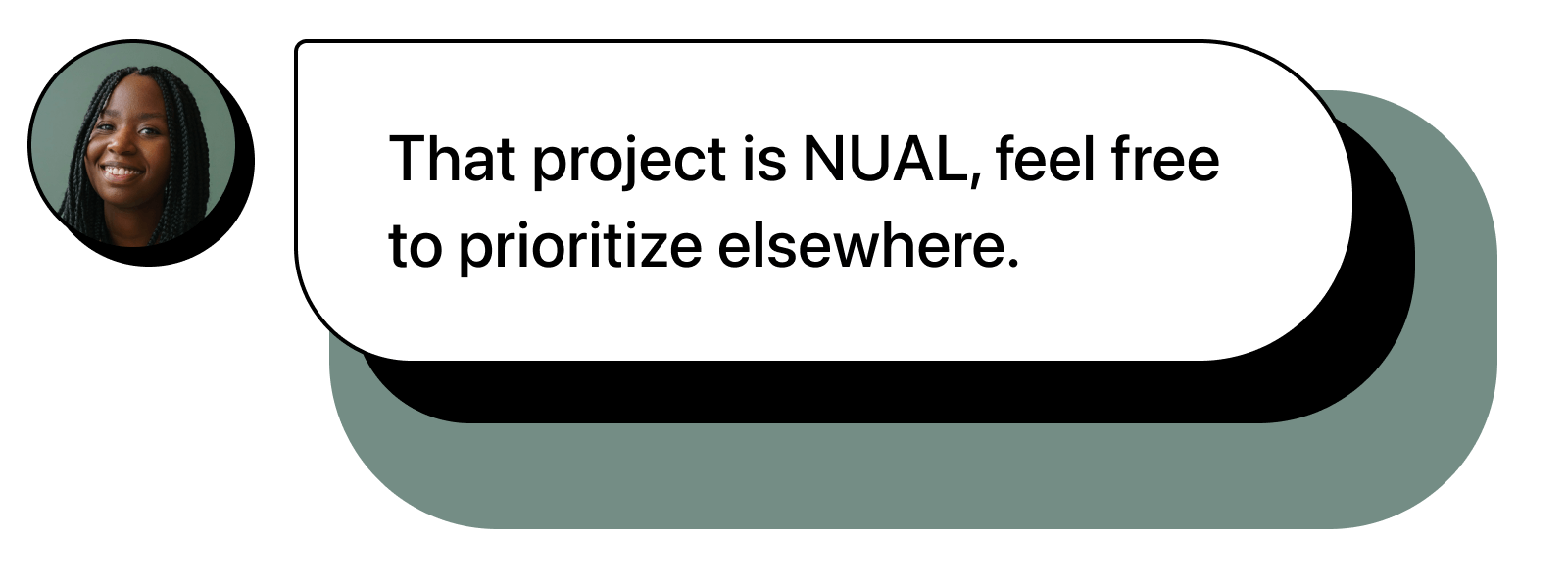
| OOO | out of the office | “I’ll be OOO from Wednesday to Friday, but I can reconnect with you next Monday. ” | Microsoft’s corporate organization has used the acronym OOF instead of OOO. It means “out of facility.” |
| PM | project manager | “Our PM said they’d have that roadmap to us by the end of next week.” | |
| POC | point of contact | “Who’s your POC on the marketing team for this project?” | Depending on the context, POC might also be an abbreviation for proof of concept or person of color. |
| PTO | paid time off | “Jane is taking PTO from Nov. 1 to Nov. 15.” | PTO is used interchangeably with paid time off and personal time off. The acronym remains the same. |
| QA | quality assurance | “How did that broken product pass the QA team?” | |
| QOQ | quarter over quarter | “What was our QOQ growth from Q1 to Q2?” | |
| RACI | a responsibility matrix (stands for responsible, accountable, consulted, and informed) | “Has this been mapped out with RACI?” | RACI was introduced in the 1950s and originally called “Linear Responsibility Charting.” Today, it is also called the Decision Rights Matrix or Responsibility Charting. RACI has plenty of variations, including RASCI, ARCI, and DACI. |
| Re | referring to (or regarding) | “She sent me an email re the broken printers, but I still don’t have an answer.” | This term is taken from the Latin in re, which means “in the matter of.” |
| ROI | return on investment | “Segmenting their email campaigns led to a 20% increase in ROI.” | ROI is one of the most popular profitability metrics, and it is always expressed in a percentage. |
| SaaS | software as a service | “It’s a SaaS product, so we’ll be paying annual fees.” | SaaS is the current de facto business model for software companies. |
| SME | subject matter expert | “We need to consult an SME—this isn’t an area of our expertise.” | SME can also refer to a small and mid-size enterprise. This refers to businesses that meet certain government-dictated criteria. E.g., “SMEs sometimes become large enterprises.” |

| TOS | terms of service | “Can you review the TOS before the vendor arrives?” | The acronym TOS has become a meme on platforms like Twitch. Users will spam a user (often using this acronym) if that user breaks the platform’s TOS. |
| UAT | user acceptance testing | “I think the feature is ready for UAT.” | UAT is one of several names for the last phase of the software testing process. It is also called beta testing, application testing, or end-user testing. |
| UGC | user generated content | “Let’s capitalize on UGC and retweet it when possible.” | UGC refers to any organic content (posts, tweets, videos, etc.) posted by the users of a social platform. |
| UI | user interface | “The backend code may be messy, but the UI is intuitive.” | The UI is the consumer-facing part of a website or app that customers interact with. |
| UX | user experience | “That website has a bad UX.” | Don Norman coined the term “user experience” for his group at Apple Computer in 1993. |
| WFH | work from home | “Hey, I’m going to WFH today. Email me if you need me.” | Since the COVID-19 pandemic, more businesses have adopted a remote work policy. These are often casually called WFH policies. |
| WOM | word of mouth | “Most of our new leads come through WOM.” | Word-of-mouth marketing (WOM marketing) is free advertising spurred by customers promoting a company to their loved ones and friends. |
| YTD | year to date | “We have boosted revenue by 5% YTD.” | Some organizations refer to their fiscal year when using the term YTD; fiscal years sometimes begin on dates other than January 1. |
When should you use text abbreviations?
Now that you know about many of the top text abbreviations, you may be tempted to use them all the time. But abbreviations are appropriate in certain situations—and not in others. It’s important to understand the texting etiquette involved.
With family and friends
You shouldn’t worry about using abbreviations with friends and family. After all, they should feel comfortable speaking up if they don’t understand the abbreviation immediately. If you have a family member who might become overwhelmed or angry if they don’t understand an abbreviation, refrain from using them with that particular person.
With colleagues
Consider your audience before sending a text abbreviation to a colleague. A coworker who is the same age as you or is close to you will probably feel comfortable using them with you. But more formal communication like texting a boss, especially one who is older or less tech-savvy, shouldn’t contain abbreviations to avoid confusion or coming across as unprofessional.
With customers
Don’t use abbreviations with a customer. There’s a chance they might not understand them, and you don’t want to confuse customers when you’re trying to connect with them. That being said, you can use a well-known text abbreviation or two if your customers use multiple abbreviations. Mirroring people can help form a powerful connection; mirroring customer language is a simple way to strengthen their relationship with your brand. Even if you use an abbreviation or two with a customer who clearly loves them, don’t use too many. You never know which abbreviations a customer will understand and which they won’t.
TL;DR
Text abbreviations are shortened versions of words or phrases. People use them to communicate through electronic msgs faster. This guide gives you a comprehensive review of the most popular abbreviations, so you can navigate modern SMS conversations with ease.
Want answers to more questions like what does LOL mean in texting? Explore our blog.




